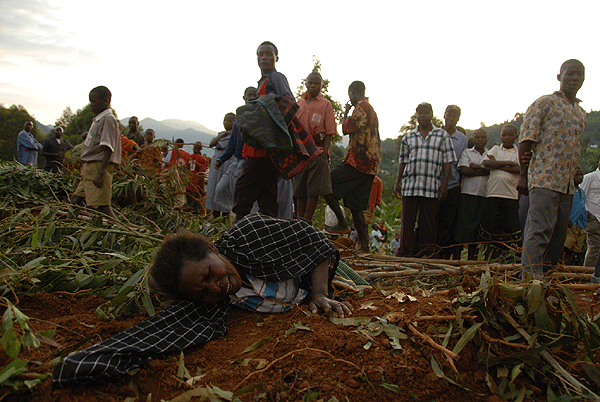Heavy rainfall, steep slopes, slope shape and high clay content in the soil generally have continued to influence the activity of land sliding in East Africa. The 2010 report by the National Environmental Management Authority (NEMA), the National Environmental watchdog, observed that during intense rain showers in Bududa, the roads, small footpaths, plot boundaries and runoff ditches concentrate large volumes of runoff water, and direct this to restricted infiltration zones or hollows. These linear features are numerous and cracks develop upon drying in the swell-shrink soils. As these cracks form a by-pass mechanism for rapid infiltration, over-saturation of the zone above the shear plane may occur with subsequent slope failure
Heavy rainfall on Thursday (11th October 2018) triggered landslides that led to heavy loss of lives and property. Bududa district has a long record of landslide activity. Studies indicate that the district is located at an average elevation of 1,800 m above sea level (a.s.l.) on the western slope of Mt. Elgon, former volcano active during the Miocene epoch (early-middle Neogene). The Bagisu tribe people living in the area remember occurrences of landslides since the early 1930s, 1954, 1983, 1997, 2006/2007 and most recently in October 2018.
Interestingly, the Kenyan side of the volcano is not subject to the same level of land sliding as it happens in the Ugandan counterpart. Kenya declared this area to be a national park in 1968, and this area was declared as a Biosphere Reserve by UNESCO in 2003.
Several studies continue to attribute these fatal situations to; Absence of drainage systems, steep slopes and changes of the land cover. Issues of High institutional vulnerability to landslides, characterized by inadequate financial and human capacity, political interference, misuse of resources, poor cooperation by the local community and lack of a sectoral law have persistently escalated the problem leading to heavy loses of both human life and property.
Study findings also reveal that afforestation and appropriate farming technologies and land use practices are the primary recommended landslide disaster risk reduction policy measures while gazetting of landslide-prone areas and prohibiting settlement in such risky areas, resettlement of people living in landslide-prone areas, and enforcement of relevant laws and regulations should be secondary. Findings also reveal that awareness is among the most important factors that influence the implementation of landslide disaster risk reduction policy measures at the household level.
Degradation of slopes through soil loss due to landslides in Bududa District is a problem with fatalities, environmental consequences and food shortages envisaged in the future. Farmlands and infrastructure such as bridges and roads have since been destroyed and this poses a big post-landslide threat to the people living around Bududa area. These landslides displace about 11,000,000m3 of soil and debris into river channels and wetlands downstream. According to the National State of Environment Reports for Uganda, it is pointed out that land is becoming increasingly scarce as the country‘s population increases at a high rate and the consequences are serious land pressure leading to land degradation. People are forced to exploit steep slopes for settlement and agriculture causing land degradation which in the end leads to increased landslides in extreme cases. More to this, a big percentage of Uganda’s population depends on agriculture for a living. The loss of soils leaves the areas bare and non-productive, which creates more pressure on land.
Landslides in Bududa have continued to occur as a result many factors one being heavy precipitation which causes mass movements of debris flow. Masses of poorly sorted sediments agitated and saturated with water move downslope hence submerging an area in a matter of minutes.
The destruction of forest cover in the area for settlement, cultivation, settlement on steep slopes and increased rainfall are also among the major contributing factors to slope instability in Bududa resulting in landslides.
We, therefore, call upon the government of the Republic of Uganda and especially the responsible agencies to benchmark on the previous studies/research findings and expedite the process of implementing a lasting solution to the Bududa landslides.
Compiled by Ronald Angarukamu, Research Fellow at Centre for Energy Governance, Uganda (CEG-Uganda)Email: [email protected]
This post was created with our nice and easy submission form. Create your post!





